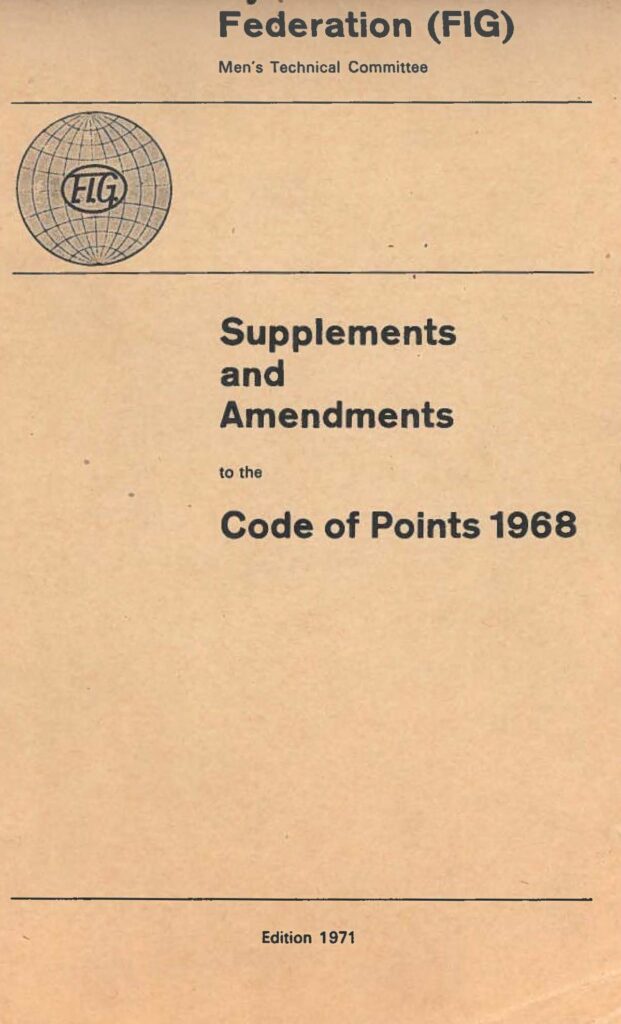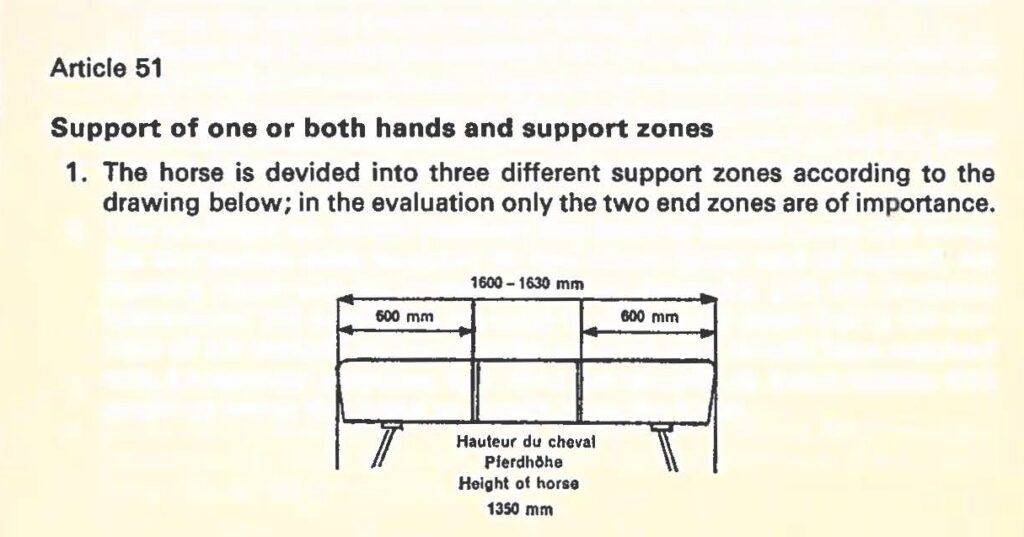In 1971, the Men’s Technical Committee issued an update to the 1968 Code of Points. But instead of printing a new document, they printed pages that were meant to be pasted over certain sections of the 1968 Code of Points. As you’ll see, the document has a funky layout as a result.
This supplement is important for two reasons. First, it established the individual all-around final. Second, it placed even more emphasis on risk, originality, and virtuosity.
Reminder: At the time, the women’s Code of Points did not have any requirements for risk, originality, and virtuosity.
Let’s take a look at the major changes…

The Big Change
The 1971 Code of Points established three major competitions:
Competition 1: The Team Competition with compulsories and optionals on the six apparatus. It also served as the qualification for the all-around finals.
Competition 2: The Individual All-Around Finals with the 36 best gymnasts from Competition 1. Previously, the team awards and the individual all-around awards were determined at the same time. The 1971 supplement established a separate individual all-around final.
Competition 3: The Individual Event Finals with the six best gymnasts qualifying from Competition 1.
The Difficulty Requirements
Each competition required more difficulty — with the Event Finals requiring the most C parts. Here’s a breakdown of the number of parts required in each competition.
| Competition 1 Team | Competition 2 All-Around | Competition 3 Event Finals | |
| # of A Parts | 4 skills 0.8 points | 3 skills 0.6 points | 2 skills 0.4 points |
| # of B Parts | 5 skills 2.0 points | 4 skills 1.6 points | 3 skills 1.2 points |
| # of C Parts | 1 skill 0.6 points | 2 skills 1.2 points | 3 skills 1.8 points |
Note: In the 1968 Code of Points, gymnasts needed to perform one C part during the team/all-around optionals (they were the same competition) and two C parts during the Event Finals.
The ROV Requirements
Each competition required increasingly more risk, originality, and virtuosity (ROV) — with the Event Finals requiring the most.
| Competition 1 (Team) | Competition 2 (AA Finals) | Competition 3 (Event Finals) | |
| Difficulty | 3.40 points | 3.40 points | 3.40 points |
| Combination | 2.60 points | ||
| Execution | 4.00 points | ||
| Starting Score | 10.00 points | 9.70 points | 9.40 points |
| ROV Bonus | – | 0.3 points | 0.6 points |
In other words, to score a 10 in the event finals, the gymnasts needed an additional 0.6 in risk, originality, and virtuosity.
Note #1: In the 1968 Code, the breakdown for the team optionals/individual all-around optionals was: 3.4 for difficulty; 1.6 for combination; 5 points for execution. In other words, the value of the combination increased while the value of execution decreased in 1971.
Note #2: In the 1968 Code, the starting score during Event Finals was 9.7 with 0.3 bonus points for ROV.
Judging Event Finals
- Two superior judges and four judges
- 1 superior judge must come from nations not participating in the event (neutral judges)
- All four judges must come from nations not participating in the event (neutral judges)
Note: In 1968, there was only one superior judge for the event finals.
Apparatus Requirements
Floor:
- Competition 1: The C part or one of the C parts must belong to swinging parts
- Competition 2: At least one of the C parts must be a swinging element
- Competition 3: At least two of the C parts must be swinging elements
- All holds: One second
- Only four running steps before a tumbling pass
Note: The document says “swinging parts” for floor exercise.

Pommel Horse
One minor addition: In the 1968 Code of Points, gymnasts had to use all three parts of the horse. The 1971 supplement clarified:
“The support of one hand at the end of the horse, during the mount, and taking away of this support without again returning to this part, cannot be considered as utilization of this part of the horse.”
Rings:
- Competition 2 At least one of the C parts must be a swinging element
- Competition 3: At least two of the C parts must be swinging elements
- Hold parts: 2 seconds; L-sit: 1 second
Vault:
- 3 support zones (See diagram below)
- Only one attempt is allowed
- Competition 3 (event finals): gymnasts must perform 2 different vaults

Note: Previously, there had been 5 support zones on vault.
Parallel Bars
- Must consist of swinging, flight, and hold parts
- Hold parts: 1 second
- Competitions 2 and 3: the flight elements must be both over and under the bars
- Competition 1: The C part or one of the C parts must belong to the swinging elements
- Competition 2 (all-around finals): At least one of the C parts must be a swinging element
- Competition 3 (event finals): At least two of the C parts must be swinging elements
High Bar
- “The minimum requirements for a maximum score for combination are exercises in dorsal hang and el-grip-hang and at least one combination leaving the grips simultaneously and regrasping the bar with both hands simultaneously.”
Download the 1971 Code of Points Supplement
You can download a copy of the document here.
One reply on “1971: The Supplement to the 1968 Men’s Code of Points”
It was a crazy way to do this. Everyone had to paste the relevant pages over pages in the 1968 Code.